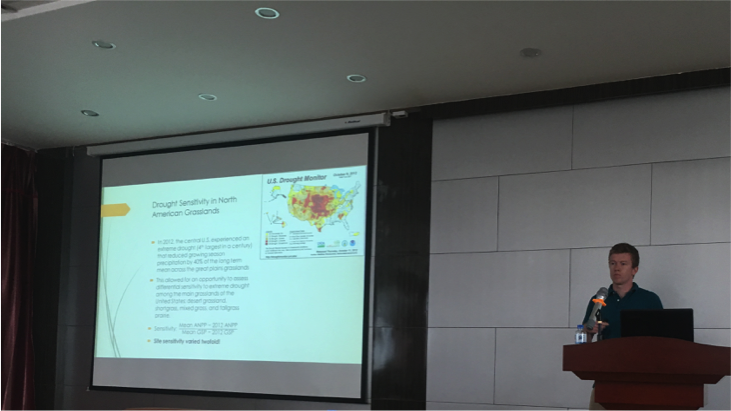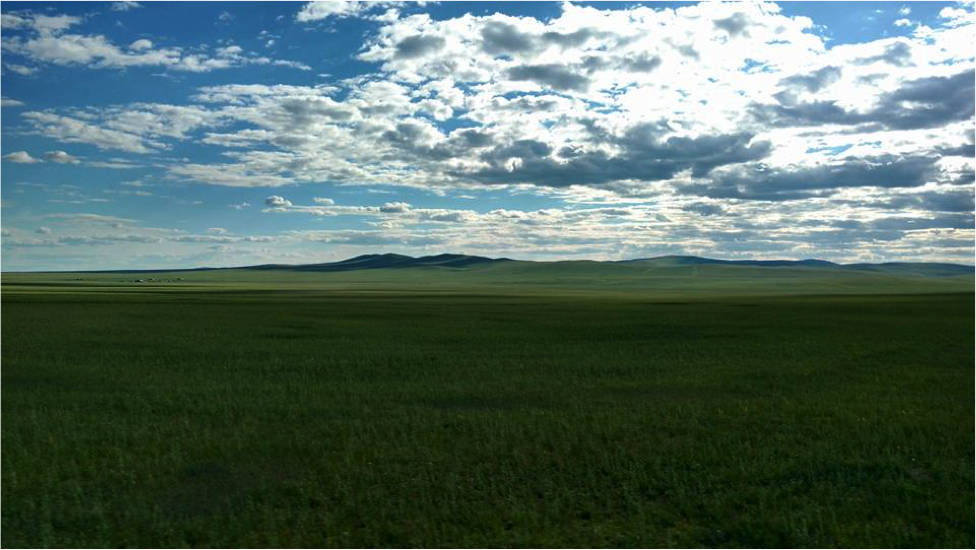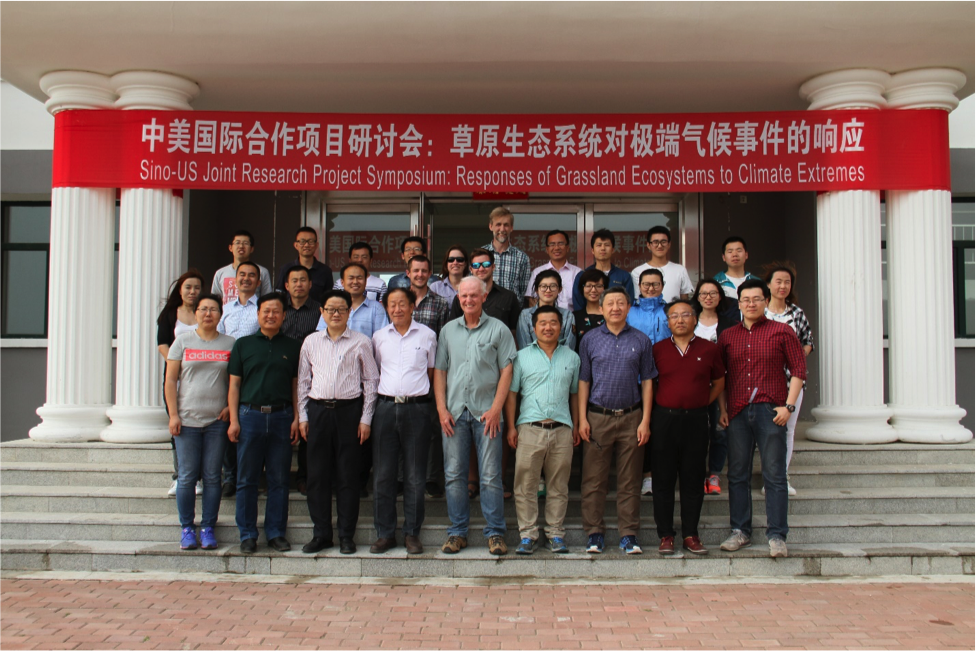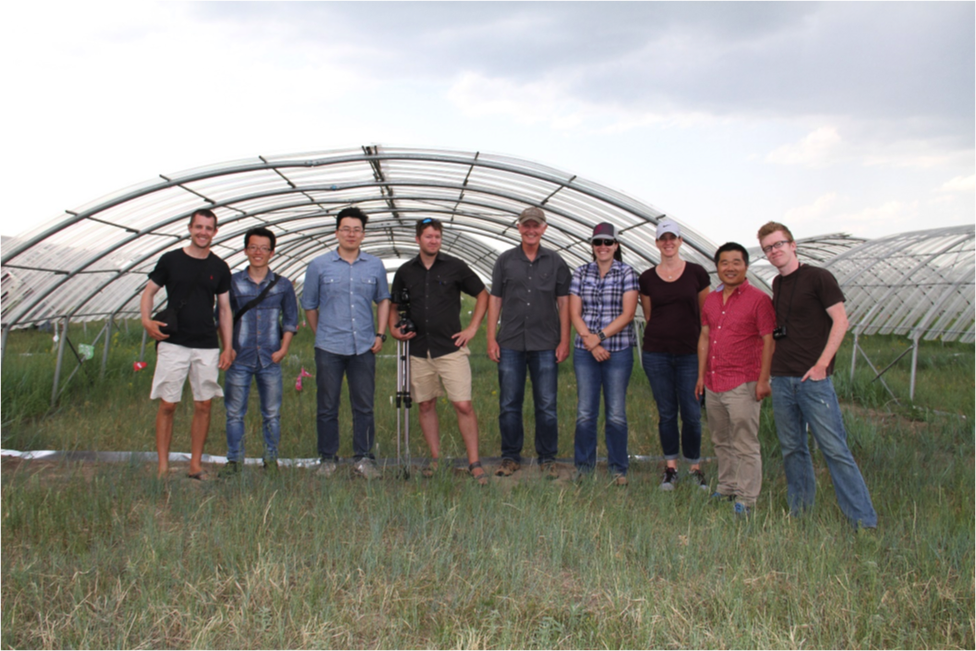
Steppe-ing up to the plate: Insights into International Collaboration
By Robert Griffin-Nolan
As an early career ecologist, attending conferences is one of my favorite ways to meet new people within and outside my field of research. I’m a plant physiologist interested in mechanisms of drought tolerance within grassland ecosystems. Many of my research questions are impossible to answer without the help of other scientists from a variety of fields. The relationships and connections that we as scientists make at conferences are crucial to long term work on complex problems, especially for ecology. The most common answer given by an ecologist when asked a specific question about our research reliably starts out: “It depends…”. There is an unfathomable amount of variability in ecological responses depending on the species, location, season, climate, the temporal/spatial scale, etc. This huge amount of variability is what makes collaboration so necessary for the field!
I’ve been going to conferences to present data since my undergraduate years, yet this past June was my first ever international meeting. Researchers from Colorado State University (CSU), University of New Mexico (UNM), and the Chinese Academy of Sciences (CAS), myself included, met in inner Mongolia to share and discuss results from the Extreme Drought in Grasslands Experiment (EDGE; http://edge.biology.colostate.edu/), a multi-site experiment aimed at understanding grassland sensitivity to extreme drought. While drought is a natural and common disturbance in grasslands, climate change is expected to increase the frequency and severity of drought, limiting the ability of grasslands – which represent over 30% of the world’s terrestrial surface – to act as carbon sinks. Using large structures that block over half of incoming rainfall, EDGE is experimentally inducing a long term (four-year) drought to mimic the dust-bowl conditions of the 1930s in central US grasslands.

My role in the project is to provide a mechanistic understanding of why certain plant species handle drought better than others. For example, species vary widely in their ability to tolerate xylem cavitation, or the formation of gas bubbles that block the flow of water in a plant’s “plumbing” system during drought. Some species, like blue grama (Bouteloua gracilis) of Colorado, can tolerate these bubbles and continue to transport water and exchange it for atmospheric carbon dioxide. Species inhabiting much drier areas such as blue grama’s cousin, black grama (Bouteloua eriopoda), in the desert grasslands of New Mexico do not tolerate such bubble formation and completely shut down water transport and gas exchange until the return of monsoon rains. Information on these small-scale processes will be assimilated into a terrestrial ecosystem model along with data on plant production, soil respiration and biodiversity to make predictions about carbon cycling in grasslands under future climatic conditions. Initially established in six grassland sites within the plains of the central US, EDGE has since expanded to include six grasslands within Inner Mongolia, greatly increasing the explanatory power of the project especially if grassland responses to drought are generalizable. Beyond increasing the scientific merit of the experiment, this collaboration allows scientists from two very different cultures to come together to address solutions to a serious problem that is and will continue to impact both countries. Climate change, after all, does not recognize borders. As for me, I was excited to fly to Inner Mongolia to be part of this collaborative process.
“If our goal is to increase ecological knowledge and address the global challenge of climate change we cannot do it alone.”
While some climate science researchers prepare well in advance of an important collaborative trip such as this, I had spent much of May and June crouching under “rain-out” shelters in the shortgrass prairies of Colorado. The 14-hour flight to China, therefore, proved a perfect venue to work undisturbed, fortified by hot peanuts and Tsingtao (a very watery but satisfying Chinese beer). When I finally stretched my legs and stepped off the plane in the city of Hailar, I was ready to meet the friendly graduate students from the Chinese Academy of Sciences. Following short introductions, we made our way out of the city by bus and into the vast green landscape that is the Mongolian Steppe. Even to those of us who spend much of our time tromping around North American grasslands, the steppe is stunning: massive rolling hills of green stretching as far as you can see; indeed, these grasslands extend all the way to Europe! For me, visiting this place in the flesh added new perspective and excitement to a project I had spent so much time reading and writing about.

About two hours into the trip, the bus pulled over and I got my chance to explore. We visited the Erguna and Hulun Buir experimental grasslands, which have been studied extensively on topics related to grazing, micro-nutrients, nitrogen, and drought. The organization of their experiments was remarkable: Fenced in areas of traditional steppe were laid out in a grid formation, each experiment with an engraved sign describing the study in Chinese (and English!). There was a nitrogen addition experiment so massive that the furthest study plots were not even in sight! This type of fertilization experiment has been replicated all over the world as part of the Nutrient Network (NutNet; www.nutnet.umn.edu), yet the extent of this specific experiment is unmatched. There are over 40 graduate students from CAS that attend to and collect data from this one experiment. Primary investigators in the US would consider themselves lucky to have one graduate student working on their experiments.
The massive amount of data coming out of these projects does present a small problem to some Chinese scientists. From speaking with some of our hosts, I learned that there is a need for native English speakers to help write these incredible ecological stories, as most high-impact journals are published in English. I did not view this as a problem, but rather an opportunity for international collaboration. The funding opportunities and large population of people interested in conducting research makes China the perfect place to tackle ecological questions that require coordinated efforts, and researchers from around the world are encouraged to be a part of this process. Indeed, we were joined at Erguna research station by an ecologist from the Netherlands doing just that.

Back on the bus, I looked forward to finally learning about the results of our collaborators first year of treatment (as well as showing off my newly minted presentation). I wasn’t prepared when we arrived for the spread of traditional inner Mongolian food and drink that greeted us: fried fish, mussels, lamb stew and glasses of infamous Baijiu (Chinese sorghum wine). To say our host were welcoming is an understatement. I took part in at least ten separate toasts as professors and graduate students came over to my table, raised a glass, and thanked me for visiting and taking part in the meeting to come. It’s a good thing Tsingtao is as watery as it is or else I may not have remembered the excellent conversations ahead of me. Over lunch we began to discuss our results and shared interests in protecting and understanding grassland ecosystems. These conversations led to plans for enhancing collaborative efforts and tackling the obvious language barrier that often makes international collaboration so difficult. One such effort involved an incoming CAS graduate student who speaks very little English but is interested in joining the EDGE project and replicating an experiment embedded within the US-EDGE sites.
Like me, this student is interested in measuring leaf hydraulic conductivity, or the flow rate of water through a leaf. The trait is highly variable among grass species in the US and can explain how the entire ecosystem responds to water availability. Species in wetter areas, such as the Konza prairie in eastern Kansas, tend to move water throughout their photosynthetic tissues more efficiently than species in drier areas such as Colorado. During drought, the pressure inside a leaf becomes more and more negative (i.e tension pressure) and bubbles of gas can be pulled into the plant’s xylem. Under the extremely low (negative) pressures that occur inside xylem cells, these bubbles of gas expand as more gas molecules come out of solution. The same process occurs when you open a can of soda, decrease the pressure inside, and allow dissolved bubbles of carbon dioxide to come out of solution. But while the bubbles in a coke are refreshing, the bubbles inside xylem can block the flow of water like a clogged artery. Testing this adaptive trait in Chinese grasses could greatly improve our understanding of plant physiology as those grasses have evolved under cooler temperatures than US grasses.
Unfortunately, the methods used to measure leaf hydraulics, which are only written in English, are complex and difficult to follow even for a native English speaker. Much of the difficulty stems from the amount of time needed to make the measurements (over 24 hours/sample). So CSU students, myself included, have volunteered to make a video presentation showing exactly how the method is performed, which eventually will be translated to Chinese by CAS students, subtitled and shared with the incoming graduate students. Luckily, a portion of the method has already been filmed and narrated by Dr. Troy Ocheltree (Troy.Ocheltree@colostate.edu) in the department of Forest and Rangeland Stewardship at CSU (https://www.youtube.com/watch?v=pTIOMtLlQVs&t). A second video describing the remainder of the method is on its way.

While the meeting in Inner Mongolia was filled with interesting stories and data sharing, it was this interaction over lunch that was most meaningful to me. Science communication is a basic ingredient in research collaboration, one that cannot be overlooked in any field but particularly with complex issues like climate change looming large. Complex problems require this type of cross-border communication. To understand global climate change we need a global effort. In October, ecologists from 33 countries gathered at Kruger National Park in South Africa for the first ever International Long Term Ecological Research (ILTER) Open Scientists Meeting (https://www.ilternet.edu/). The meeting brought together scientists from several organizations that focus their funding on long term ecological research including both North American and European LTER programs (https://lternet.edu/ and http://www.lter-europe.net/) the National Ecological Observatory Network (NEON, http://www.neonscience.org/), as well as the South African Environmental Observation Network (SAEON, http://www.saeon.ac.za/). These networks are founded on collaboration and understanding the long-term impacts of climate change. Their efforts should be encouraged. If our goal is to increase ecological knowledge and address the global challenge of climate change we cannot do it alone.
Robert Griffin-Nolan is a PhD. student studying plant physiology and the impact of extreme drought on grassland ecosystems. For more information on Robert and EDGE check out his bio here: http://edge.biology.colostate.edu/people.html/
Connect with EcoPress on social media! Like us on Facebook and follow us on Twitter, @nrel_science, for the more stories and news.